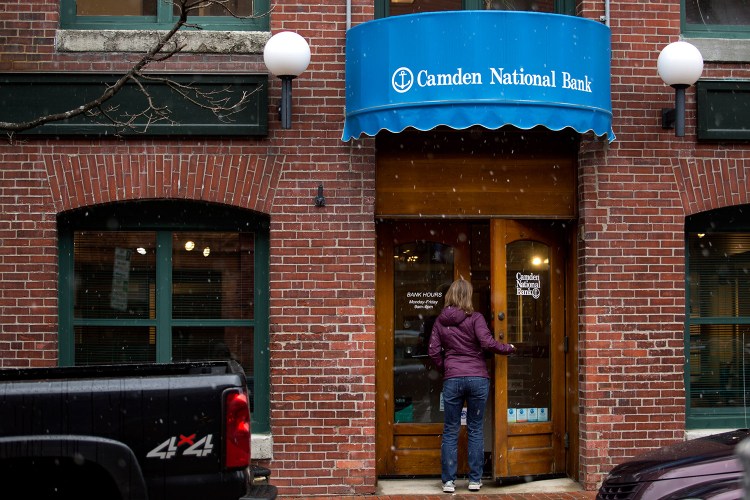Camden National Bank announced plans Monday to acquire The Bank of Maine in a $135 million deal that will make it Maine’s largest locally owned bank.
The acquisition, if successful, would significantly increase Camden National’s presence in Portland, where The Bank of Maine is headquartered, and allow it to surpass Bangor Savings Bank as the largest Maine-based bank.
The merged bank would have 68 branches from York to Calais – though a few of these would likely close post-merger – about 700 employees, and more than $3 billion in assets, according to the Federal Deposit Insurance Corp.
For Camden National, a bank formed in 1875, the deal marks the latest in a series of acquisitions that began two decades ago when it acquired United Bank in Bangor. Its most recent acquisition occurred in 2012, when it purchased 15 branches from Bank of America.
The deal is part of a national trend toward consolidation in the banking industry that has caused the number of independent banks to decline by more than half over the past three decades.
Reasons for the acquisition include increasing Camden National’s footprint in the high-growth southern Maine market, and allowing it to reach economies of scale that will make it more affordable to invest in technology and handle the increasing compliance costs that banks face in the wake of the financial crisis, according to Gregory Dufour, Camden National’s CEO.
Camden National is the larger of the two banks. As of Dec. 30, 2014, Camden National had 44 branches, $2.7 billion in assets and nearly $1.9 billion in deposits, according to the FDIC. The Bank of Maine had 24 branches, $805 million in assets and $658 million in deposits.
The acquisition fills in some geographical gaps for Camden National, especially along what Dufour calls the “I-95 corridor.” Camden National will gain branches in areas it doesn’t currently cover, including Brunswick, Bath, Topsham, Falmouth, Saco and York. The acquisition of The Bank of Maine branch at 2 Canal Plaza in downtown Portland will significantly increase Camden National’s exposure in Maine’s largest market.
“When you look at the economic growth of the state, we’re extremely well-positioned now in all the markets,” Dufour said.
In total, Dufour expects the acquisition to save the combined organization $11 million through various synergies, including branch closures and layoffs where there are overlapping operations. The two banks currently have 740 employees, Dufour said.
Camden National and The Bank of Maine have eight branches within one mile of each other, in Augusta, Gardiner and Kennebunk. After the acquisition is complete, Dufour will look at the individual performance of branches and whether they are big enough to accommodate the expected increase in customer traffic, and then decide which branches will close.
“Over the next several weeks, we’ll identify those areas, but will look to absorb some of the displaced staff in positions that are currently vacant or will become vacant through normal turnover,” he said.
The acquisition – Dufour prefers to call it a merger because it offers an opportunity to merge the best products, ideas and “ways of thinking” from both organizations – offers Camden National a chance to “redefine” itself in a changing industry challenged by new technology and evolving customer expectations such as online banking options, he said.
“We have to constantly redefine ourselves to deliver not only technology, but changing standards customers have now,” Dufour said. “You can only do that by joining forces.”
The deal is expected to close by the end of the third quarter of 2015.
Once the deal is complete, Camden National will communicate with customers of both banks to explain how the changes will affect them.
TAKING OVER THE TOP SPOT
The new Camden National would have roughly $3.5 billion in assets and $2.5 billion in deposits, which would surpass Bangor Savings Bank’s $3.1 billion in assets and nearly $2.3 billion in deposits.
Bangor Savings Bank has been the largest Maine-based bank since Toronto-based TD Bank Group became the majority shareholder of Portland-based Banknorth in 2004.
The shifting landscape doesn’t faze Yellow Light Breen, chief strategic officer at Bangor Savings Bank.
“Overall it doesn’t really affect us whether we wind up being described as the largest bank on any given day,” he said. “Our goal is to be the best bank in Maine.”
In fact, Breen sees Camden National’s acquisition as an opportunity for Bangor Savings Bank.
“Disruption from mergers always offers opportunities for other banks in the marketplace to catch the notice of potential customers,” he said. “These things are not easy to pull off. Major acquisitions take a ton of attention and energy to pull off and that means those banks are actually less focused on the market for a while, acquiring customers and serving customers.”
Being labeled the largest bank in Maine does come with an innate advantage, however, according to Gerard Cassidy, managing director of bank equity research for RBC Capital Markets.
It immediately brings recognition from customers, especially large corporate customers, that your bank is able to provide the necessary level of service, said Cassidy, who covers publicly traded banks on the East Coast from RBC’s Portland office.
“It’s a nice balance to have today,” he said, “where they can handle needs of large customers, but at the same time not forget about smaller customers.”
In the 1980s, there were more than 14,000 independent banks in the United States. Today there are roughly 6,000.
That steep decline is the result of consolidation, Cassidy said.
“The economies of scale are important because it’s a commodity product. A loan from Camden National is no different than from Bank of America,” he said. “The banks that recognize they’re in a commodity business focus on driving their overhead costs down, which is what consolidation enables them to do.”
Cassidy expects the consolidation trend to continue nationwide, further halving the number of banks over the next 20 years. However, Maine and its 27 local banks will see less consolidation over that period because so few of Maine’s banks are publicly traded, Cassidy said. Publicly traded banks are more likely to seek mergers and acquisitions because their CEOs are accountable to stockholders who expect a certain return on investment. But mutual savings banks, such as Bangor Savings Bank and Gorham Savings Bank, are owned by their depositors and not under pressure to provide returns to investors. Maine’s publicly traded banks include Camden National, First Bancorp in Damariscotta, Northeast Bancorp in Lewiston and Bar Harbor Bankshares.
“The depositors don’t have the same demands publicly traded shareholders do,” Cassidy said.
THE BANK OF MAINE
Founded in 1834 as Gardiner Savings Institution, The Bank of Maine ran afoul of federal regulators who issued a cease-and-desist order in 2009 when it was the Savings Bank of Maine. The feds faulted the bank for being undercapitalized and making risky commercial loans. Arthur Markos, who was president of Savings Bank of Maine, said at the time the bank was trying to help small businesses and consumers weather the recession and was more lenient with loan qualifications than the Office of Thrift Supervision thought prudent. In 2010, a group of investors formed SBM Financial and absorbed the bank’s holding companies, restructured its debt and poured $60 million into it, exceeding the federal requirement for capitalization.
In 2011, it changed its name to The Bank of Maine and moved its headquarters to Portland. Under current CEO John Everets, The Bank of Maine has bounced back. Since 2011, it has made more than $1 billion in new and renewed loans and added roughly 20,000 new customers, Everets said.
While Dufour said the acquisition has been in the works for eight weeks, Everets said his conversations with Dufour about a potential deal go back much further. Given the two banks’ complementary geographic footprints, company culture and management style, Everets called the deal a “natural evolution.”
Besides its traditional banking business, The Bank of Maine also has a mortgage company and a health care finance company, which provides commercial loans to medical offices, with a national book of business.
Healthcare Professional Funding Corp. “needs a larger balance sheet to grow,” Everets said. “These are hopefully significant drivers of growth in the future.”
Everets will remain with the company to consult through the transition, but whether he has any plans after that, he wouldn’t say.
“We’ll see what the organization needs and see what happens,” he said Monday. “I’m dedicated to making these two wonderful entities come together in a very positive and seamless way and make sure they have a very bright future.”
Camden National will pay stockholders of SBM Financial Inc., The Bank of Maine’s parent company, a combination of stock and cash valued at approximately $135 million, according to the merger agreement filed with the U.S. Securities and Exchange Commission. The merger agreement calls for 80 percent of SBM Financial’s common shares to be converted to Camden National common stock, and the remaining 20 percent to be exchanged for cash.
Send questions/comments to the editors.





Success. Please wait for the page to reload. If the page does not reload within 5 seconds, please refresh the page.
Enter your email and password to access comments.
Hi, to comment on stories you must . This profile is in addition to your subscription and website login.
Already have a commenting profile? .
Invalid username/password.
Please check your email to confirm and complete your registration.
Only subscribers are eligible to post comments. Please subscribe or login first for digital access. Here’s why.
Use the form below to reset your password. When you've submitted your account email, we will send an email with a reset code.